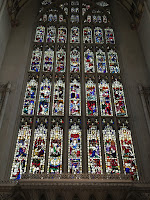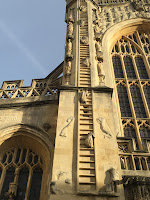
 UNESCO has named Bath a World Heritage site of Outstanding Universal Value largely due to the presence of the Roman Baths and Temple of Sulis Minerva, but Bath has much more to offer. Bath Abbey built by Henry VII stands just a few steps from the Roman Baths and is a stunning example of Gothic Architecture that blends in seamlessly with the Georgian style that makes up the remainder of the city. Though the Abbey had not been completed by the time the first Tudor king's son enacted the Dissolution of the Monasteries, Bath Abbey, unlike so many other religious houses, survived the wrath of Henry VIII. One of the most eye-catching features of the front of this church is the ladder that begins at the top of the church door and displays angels traversing to and from heaven. The interior of the Abbey is no less riveting with extraordinary stained glass that is a more recent addition since the original glass did not escape Henry VIII's notice. Started in 1499, Bath Abbey may be the latest example of medieval cathedral architecture, and it continues as a center of worship to this day.
UNESCO has named Bath a World Heritage site of Outstanding Universal Value largely due to the presence of the Roman Baths and Temple of Sulis Minerva, but Bath has much more to offer. Bath Abbey built by Henry VII stands just a few steps from the Roman Baths and is a stunning example of Gothic Architecture that blends in seamlessly with the Georgian style that makes up the remainder of the city. Though the Abbey had not been completed by the time the first Tudor king's son enacted the Dissolution of the Monasteries, Bath Abbey, unlike so many other religious houses, survived the wrath of Henry VIII. One of the most eye-catching features of the front of this church is the ladder that begins at the top of the church door and displays angels traversing to and from heaven. The interior of the Abbey is no less riveting with extraordinary stained glass that is a more recent addition since the original glass did not escape Henry VIII's notice. Started in 1499, Bath Abbey may be the latest example of medieval cathedral architecture, and it continues as a center of worship to this day.Both of these popular tourist stops are ones that you should not miss, but the magic of Bath is the city itself. Designed by father and son architects, John Wood Senior and Junior, along with Ralph Allen and Richard Nash, Bath is the result of a dream to create the most beautiful city in the world. Many agree that they achieved this goal. The city was completely rebuilt in the 18th century to create an inviting and aesthetically pleasing community. The buildings are built from locally quarried Bath Stone that has a light golden color similar to sandstone. The facades of terrace houses were designed to give a uniform appearance of a single structure, while residents were free to design their homes as they chose behind the facade. The result is a hodgepodge of sizes and evidence of originality if you get a rear view of one of the row houses.
 Some of the best known and most visually stunning examples of Bath architecture include the Circus, Pulteney Bridge, and the Royal Crescent.
Some of the best known and most visually stunning examples of Bath architecture include the Circus, Pulteney Bridge, and the Royal Crescent.The Circus was designed by John Wood in the fashion of the Roman Colosseum, circular in form and growing more ornate as one moves up the height of the buildings. Wood used the dimensions of Stonehenge as the basis of his design, creating a 318' diameter for the elegant curved structures. Unfortunately Wood did not survive to see more than the beginning of construction, which was then finished by his son.
John Wood the Younger also went on to design the Royal Crescent, another curved facade that looks out onto Victoria Park. Very similar in style to the Circus buildings, the Royal Crescent stretches 30 townhouses wide and includes some of the highest priced real estate in the city.
Completed in 1774, Pulteney Bridge was designed to imitate Venetian style architecture with shops lining the entire span of the bridge. While the bridge has undergone renovations and rebuilding in the years since, it remains one of only four bridges of its type in the world.

Bath has long been a desirable home for those who love the architecture nestled within natural beauty as well as a private getaway for the rich and famous. Strolling down the streets that seem to have emerged straight from a storybook, you will quickly understand why.






Lovely Samantha! Your posts are so insightful. I really look forward to them.
ReplyDeleteThank you! I enjoy writing them as well. :-D
DeleteI am so glad to know about these details of these brilliant historic places. I am in love with the photos. I am looking for some popular historic party venues in Chicago and not finding anything which is up to my expectations and budget.
ReplyDeleteGlad you enjoyed it, Mark!
Delete